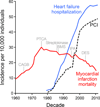Stem cell therapy for heart failure: Ensuring regenerative proficiency
- PMID: 27020904
- PMCID: PMC4912443
- DOI: 10.1016/j.tcm.2016.01.003
Stem cell therapy for heart failure: Ensuring regenerative proficiency
Abstract
Patient-derived stem cells enable promising regenerative strategies, but display heterogenous cardiac reparative proficiency, leading to unpredictable therapeutic outcomes impeding practice adoption. Means to establish and certify the regenerative potency of emerging biotherapies are thus warranted. In this era of clinomics, deconvolution of variant cytoreparative performance in clinical trials offers an unprecedented opportunity to map pathways that segregate regenerative from non-regenerative states informing the evolution of cardio-regenerative quality systems. A maiden example of this approach is cardiopoiesis-mediated lineage specification developed to ensure regenerative performance. Successfully tested in pre-clinical and early clinical studies, the safety and efficacy of the cardiopoietic stem cell phenotype is undergoing validation in pivotal trials for chronic ischemic cardiomyopathy offering the prospect of a next-generation regenerative solution for heart failure.
Keywords: Cardiopoiesis; Cardiopoietic stem cell; Cardiovascular disease; Clinical trial; Clinomics; Epidemic; Health care; Myocardial infarction; Next generation; Quality; Regenerative medicine; System.
Copyright © 2016 The Authors. Published by Elsevier Inc. All rights reserved.
Figures







Comment in
-
Editorial Commentary: Reprogramming autologous mesenchymal stem cells to regenerate the lost myocardium in chronic heart failure: Reboot and restore?Trends Cardiovasc Med. 2016 Jul;26(5):405-6. doi: 10.1016/j.tcm.2016.02.001. Epub 2016 Mar 4. Trends Cardiovasc Med. 2016. PMID: 26952041 No abstract available.
Similar articles
-
Mass Customized Outlook for Regenerative Heart Failure Care.Int J Mol Sci. 2021 Oct 22;22(21):11394. doi: 10.3390/ijms222111394. Int J Mol Sci. 2021. PMID: 34768825 Free PMC article. Review.
-
Cardiac regeneration in 2017: Novel paradigms in the fight against heart failure.Nat Rev Cardiol. 2018 Jan 16;15(2):73-74. doi: 10.1038/nrcardio.2017.218. Nat Rev Cardiol. 2018. PMID: 29336435 Review. No abstract available.
-
Cell therapy trials for heart regeneration - lessons learned and future directions.Nat Rev Cardiol. 2018 Nov;15(11):659-671. doi: 10.1038/s41569-018-0013-0. Nat Rev Cardiol. 2018. PMID: 29743563 Review.
-
New era of heart failure therapy in pediatrics: Cardiac stem cell therapy on the start line.J Thorac Cardiovasc Surg. 2019 Sep;158(3):845-849. doi: 10.1016/j.jtcvs.2019.05.002. Epub 2019 Jun 24. J Thorac Cardiovasc Surg. 2019. PMID: 31248633 No abstract available.
-
Myocardial cell sheet therapy and cardiac function.Am J Physiol Heart Circ Physiol. 2012 Nov 15;303(10):H1169-82. doi: 10.1152/ajpheart.00376.2012. Epub 2012 Sep 21. Am J Physiol Heart Circ Physiol. 2012. PMID: 23001836 Review.
Cited by
-
Cardiopoietic cell therapy for advanced ischaemic heart failure: results at 39 weeks of the prospective, randomized, double blind, sham-controlled CHART-1 clinical trial.Eur Heart J. 2017 Mar 1;38(9):648-660. doi: 10.1093/eurheartj/ehw543. Eur Heart J. 2017. PMID: 28025189 Free PMC article. Clinical Trial.
-
Mass Customized Outlook for Regenerative Heart Failure Care.Int J Mol Sci. 2021 Oct 22;22(21):11394. doi: 10.3390/ijms222111394. Int J Mol Sci. 2021. PMID: 34768825 Free PMC article. Review.
-
M3RNA Drives Targeted Gene Delivery in Acute Myocardial Infarction.Tissue Eng Part A. 2019 Jan;25(1-2):145-158. doi: 10.1089/ten.TEA.2017.0445. Epub 2018 Sep 21. Tissue Eng Part A. 2019. PMID: 30047313 Free PMC article.
-
Roles of FGF Signals in Heart Development, Health, and Disease.Front Cell Dev Biol. 2016 Oct 18;4:110. doi: 10.3389/fcell.2016.00110. eCollection 2016. Front Cell Dev Biol. 2016. PMID: 27803896 Free PMC article. Review.
-
CD51 distinguishes a subpopulation of bone marrow mesenchymal stem cells with distinct migratory potential: a novel cell-based strategy to treat acute myocardial infarction in mice.Stem Cell Res Ther. 2019 Nov 20;10(1):331. doi: 10.1186/s13287-019-1439-y. Stem Cell Res Ther. 2019. PMID: 31747966 Free PMC article.
References
-
- Braunwald E. The ten advances that have defined modern cardiology. Trends Cardiovasc Med. 2014;24:179–183. - PubMed
-
- Menees DS, Peterson ED, Wang Y, Curtis JP, Messenger JC, Rumsfeld JS, Gurm HS. Door-to-balloon time and mortality among patients undergoing primary PCI. N Engl J Med. 2013;369:901–909. - PubMed
-
- Mozaffarian D, Benjamin EJ, Go AS, Arnett DK, Blaha MJ, Cushman M, et al. American Heart Association Statistics Committee and Stroke Statistics Subcommittee. Heart disease and stroke statistics--2016 update. Circulation. 2016;132
-
- Jessup M. The heart failure paradox: an epidemic of scientific success. Circulation. 2014;129:2717–2722. - PubMed
Publication types
MeSH terms
Grants and funding
LinkOut - more resources
Full Text Sources
Other Literature Sources
Medical

